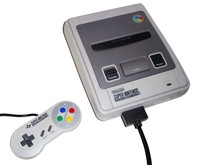Super Nintendo Entertainment System (SNES)
| Home > Browse Our Collection > Games Consoles > Nintendo > Super Nintendo Entertainment System (SNES) |
|
The Super Nintendo Entertainment System (also known as the Super NES, SNES or Super Nintendo) is a 16-bit video game console that was released in 1990 by Nintendo in Japan, 1991 in North America, 1992 in Europe & Australasia (Oceania), and South America in 1993. In Japan and Southeast Asia, the system is called the Super Famicom, officially adopting the abbreviated name of its predecessor, the Family Computer), or SFC for short. The Super Nintendo Entertainment System is Nintendo's second home console, following the Nintendo Entertainment System (NES). The machine introduced advanced graphics and sound capabilities compared with other consoles at the time. Additionally, development of a variety of enhancement chips (which were integrated on game circuit boards) helped to keep it competitive in the marketplace. Initially programmers found the machines architecture difficult to program for, as it relied very heavily on it's custom chips to produce such effects as the famous mode 7, which allowed a flat image to be transformed into a kind of 3D and rotated. The actual CPU of the machine was a rather slow, modified 8 Bit chip with a 16 bit bus. As the traditional method of games programming at this stage was with heavy reliance on the CPU, it meant the early games particularly shooting titles tended to suffer from slow down, as the weak processor struggled to cope. With time and better development tools, these problems could be worked around, but the machine would always have the reputation of being difficult to work with. The American machine has a much more severe appearance than the other regions, to make it look much more like the NES. This European SNES was released first in the UK and Ireland in April 1992, and in the rest of Europe a few months later, Nintendo originally planned to use the American design for Europe, but the feedback from consumers and magazines was negative, so the Super Famicom design was rebranded and used instead, unfortunately, the machine, and most of its software was not optimised for the slower PAL TV 50 Hz system, which meant the machine ran 17.5% slower than the Japanese and US Systems, which were NTSC and 60%, also the games had large borders at the top and bottom of the screen, because PAL has more lines to its picture. The machines were a global success, becoming the best-selling consoles of the 16-bit era despite its relatively late start, although considerable market share was lost to Sega with the fierce competition it faced in North America and Europe from their Mega Drive/Genesis console. The SNES remained popular well into the 32-bit era, and continues to be among fans, collectors, retro gamers, and emulation enthusiasts, some of whom are still making homebrew ROM images. Manufacturer: Nintendo Type: Video game console Our system is in excellent condition with a serial number of UP 17250379. Manufacturer: Nintendo Magazines RELATED to Super Nintendo Entertainment System (SNES) in our Library
This exhibit has a reference ID of CH24546. Please quote this reference ID in any communication with the Centre for Computing History. |
Click on the Image(s) For Detail
|












